The collaborative, locally sourced, internationally themed, contemporary and historical exhibit “Hair Me Out” is now installed on the Upper Level of the Davis Family Library and includes multimedia components in the atrium. It explores the political, diasporic and stylistic phenomena surrounding Black hair from all around the world. This exhibit will be installed from February 21st through March 20th. Stop by to see it and visit go.middlebury.edu/hairmeout to see its digital representation.
Who’s involved in this latest exhibit?
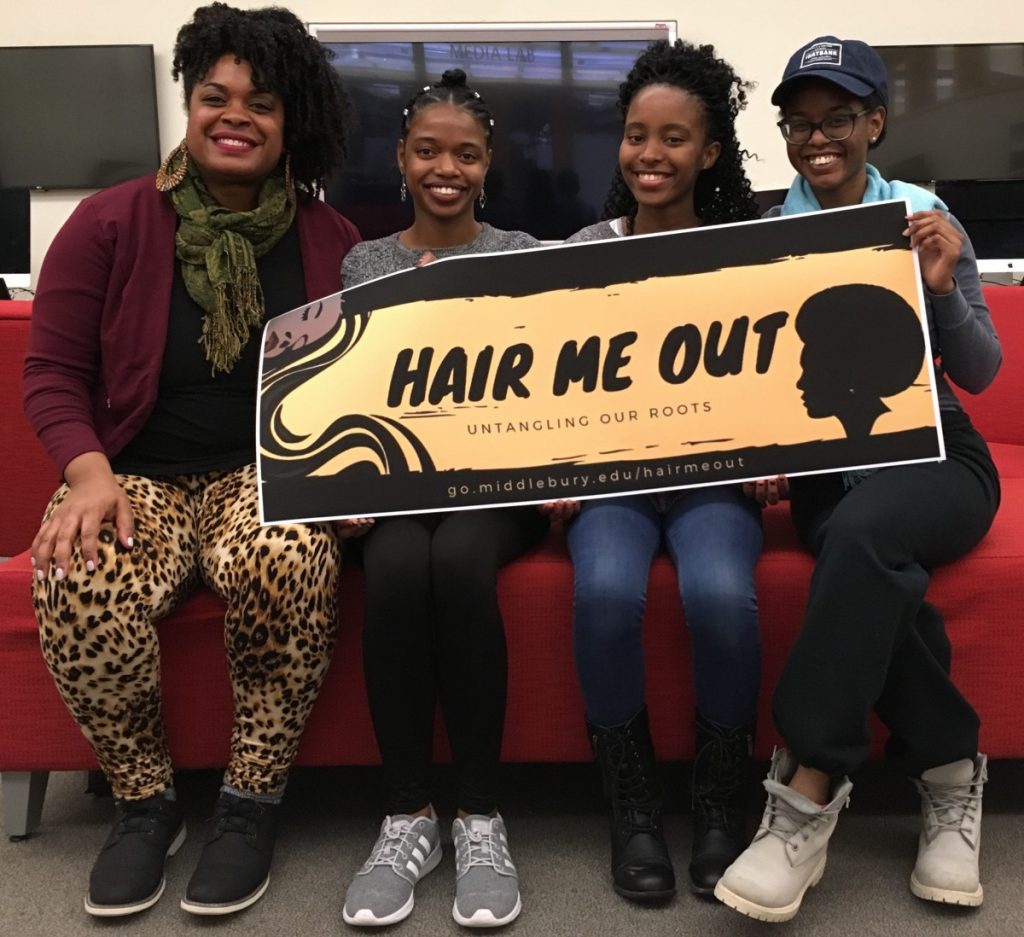
Four members of the crew working on the Hair Me Out Exhbit, from left to right: Katrina Spencer, Kizzy Joseph, Thandwa Mdluli, Jade Moses.
Katrina Spencer (Literatures & Cultures Librarian) [KS]: Roll Call/ Credits:
- Jade Moses, a sophomore from New York and Guyana who studies Psychology
- Thandwa Mdluli, a sophomore from the small kingdom of Swaziland who studies Psychology and may seek a minor in Dance
- Kizzy Joseph, a senior from New York and Grenada who studies American Studies and is pursuing a double minor in African American Studies and Education Studies
- Betty Kafumbe, a staff member in the Finance/Controller’s Office from Uganda

A small portion of the cast responsible for the Hair Me Out Display, from left to right: Betty Kafumbe, Katrina Spencer and Jade Moses.
- Professor Christal Brown from North Carolina who is Chair of the Dance Program
- Natasha Ngaiza, a Tanzanian American Visiting Assistant Professor of Film and Media Culture
- Lydia Clemmons, a community member whose parents, Dr. Jackson and Mrs. Lydia Clemmons, are owners of the Clemmons Family Farm
- Myself, a librarian from Los Angeles who regularly encourages creative and collaborative projects
“Hair Me Out”? Is that a pun?
KS: It is! And all credit goes to our punny Jade Moses! Installed from February 21st through March 20th, the Hair Me Out exhibit is an opportunity for Black staff, students and faculty to showcase many of the ways we engage with our hair. The texture of our hair is one of the most definitive markers of our ethnic and racial identities and has suffered a great deal of persecution for centuries and even today with bans of dreadlocks (2012), Afros (2016) and braids (2017) still happening in schools, on work sites and in the armed forces in the United States, in parts of Africa and throughout the Black diaspora. The rise of the natural hair movement has invited Black peoples to re-embrace our hair in its natural state and has granted Black peoples license to appreciate our hair anew. A variety of styles and testimonies can be seen on the exhibit’s digital home page at go.middlebury.edu/hairmeout.
The Hair Me Out exhibit includes and represents this trend and the many others– weaves, extensions, press ‘n’ curls, relaxers, finger waves, et al– that have come in and out of popularity over time, inviting in-groups and out-groups to critically engage with this highly politicized part of our personhood. Have you ever wondered why Michelle Obama hasn’t been seen with an Afro? Or why Barack Obama hasn’t sported cornrows while delivering the State of the Union address? Hair has meaning and Hair Me Out taps into it.
How did you decide what to include?
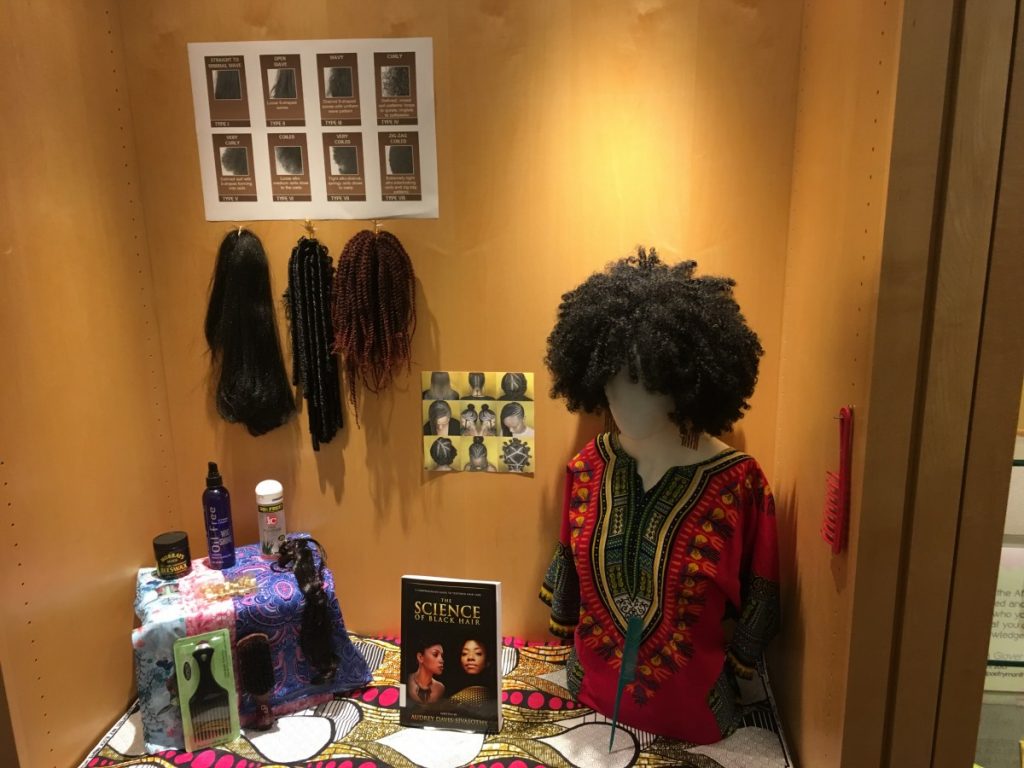
Part of the Hair Me Out Exhibit including a wig, hair literature and styling products
KS: As “we” say, “from jump” we knew that we would be working without a budget so we had to be creative about what we would include. Aside from books, mannequins and stands, 100% of the items– dashikis, wigs, combs, busts, pins etc.– and products– creams, oils, butters, etc.– are personal property belonging to some member of the group.
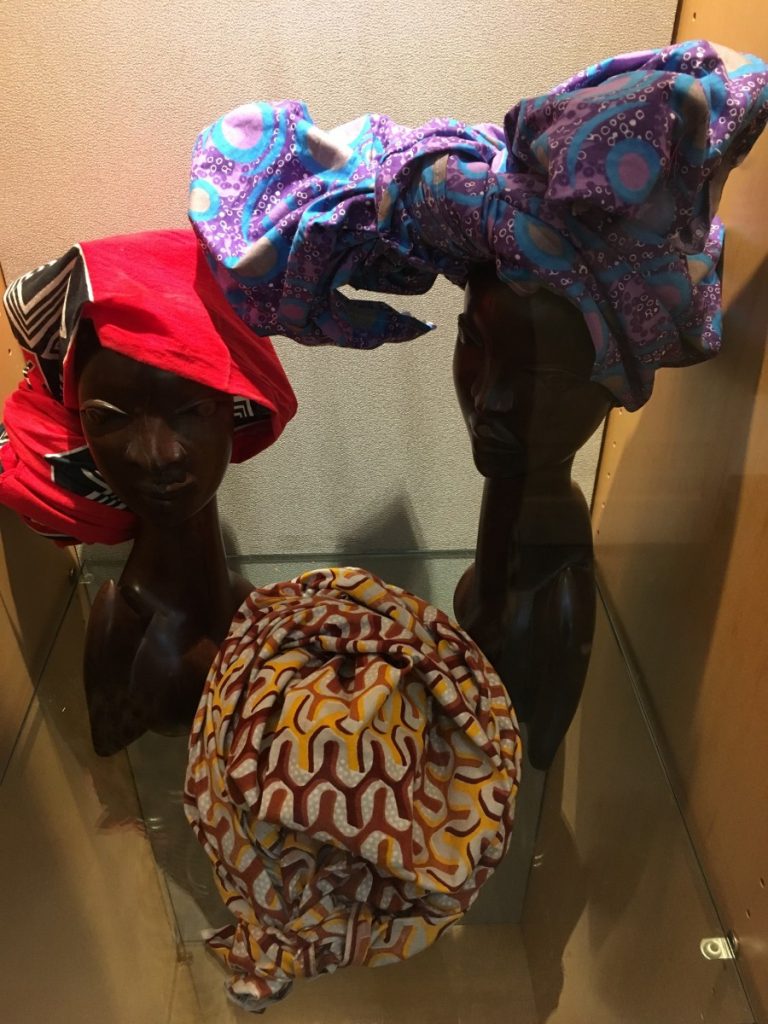
Two wooden busts adorned with colorful head wraps
Lydia Clemmons from the local and Vermont-based Clemmons Family Farm really came through with beautiful items and realia sourced from West Africa: wooden statuettes of Black women with textured carvings of hair. When I provided the seed of an idea for this project, my vision was rather modest. It has grown impressively under the careful and loving eyes of many.
Is there co-programming that goes along with this?
KS: Yes! Newly tenured dance professor Christal Brown has leant her prowess in inviting both a barber and hair stylist to come to Middlebury to offer discounted services to students. Men’s barber, “Kev,” will arrive on February 25th to Solos Salon Associates on Court Street. See the Facebook event here. And Linda Hill will be available at the same place on March 4th and 5th. See the Facebook event here. Both are ready to create a variety of styles for community members who normally have limited local access to Black hair experts.
Also, a cycle of screenings of thematic films has already commenced! UMOJA, the African Student Union, has screened Yellow Fever, a short film on Blackness and hair. And You Can Touch My Hair will be shown by Women of Color (WOC) this coming Wednesday, February 21st at 7:00 p.m. in Chellis House.
What was the most challenging part of developing this?
KS: For me, I was literally involved in three other projects– the Black History Month Display, In Your Own Words and Black History Month Jeopardy— when I presented ideas around an exhibit that centered Black hair. I had figuratively tied my own hands because if I were to carry out the first three projects well, it was in no one’s interest that I take on a fourth as there are only so many hours in the day. That said, as you know, Middlebury starts its Spring semester in the middle of February [Black History Month], thusly, much of the planning for this effort needed to happen during J-Term. The group was very invested, working after class and even during the week of interim between J-Term and the Spring semester. I am continually impressed by their efforts.
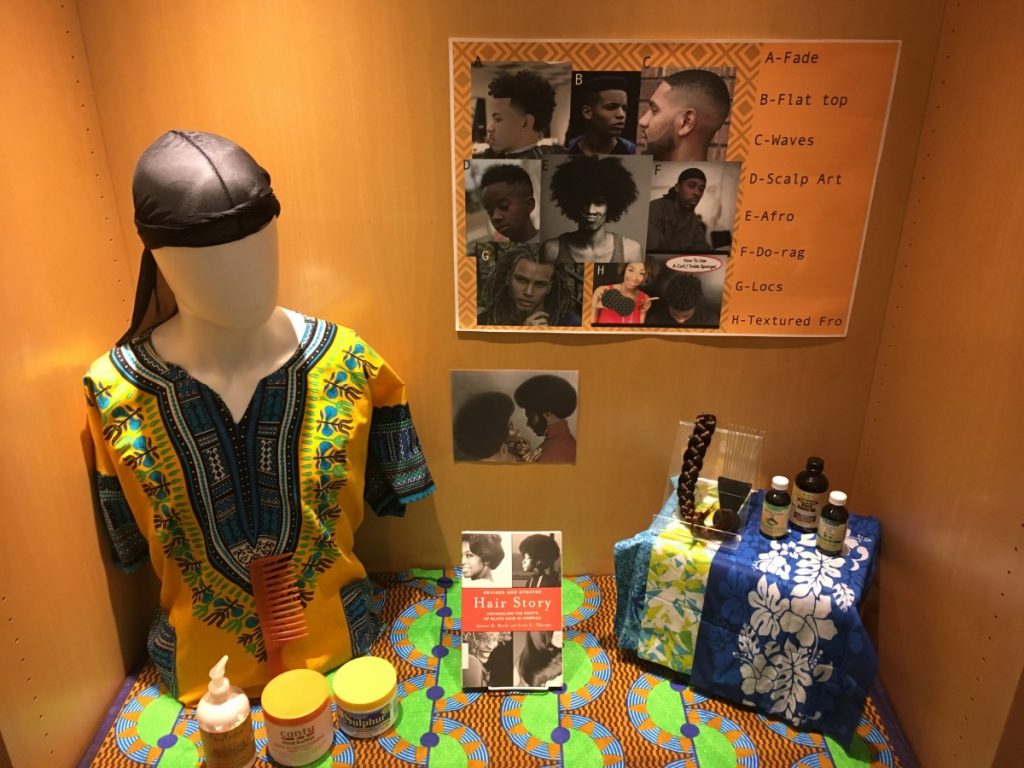
Part of the Hair Me Out Exhibit including creams, oils and synthetic hair
Of what are you most proud?
KS: I like to entertain myself with the idea that to some extent I educated these women on new uses of the library. Throughout this process, if they did not know how to do so before, they learned how to make purchase requests to grow our collections, how to navigate licensing for the public screening of films and they made many new contacts from Special Collections, Circulation in reserving spaces, props and materials and perhaps Digital Media Tutors in the Wilson Media Lab. I like to think it was a covert and crafty mission of mine in getting them to know new things but they were always open, willing, engaged, aware and quite awake. . . so I’m not that clever. LOL Middlebury students are very smart. And they miss nothing. Nothing is lost on them.
What do you hope others will gain from this exhibit?
KS: I’d love for them to sit with the idea of diaspora and gain a deeper understanding that there are Black people– black and brown humans worthy of dignity– all over the planet. I want people who do not identify as Black to gain a deeper of understanding of how much those of us who do identify as Black care about and for our hair. I want others to know that they, too, can take greater ownership of library spaces.
What did you learn in the process?
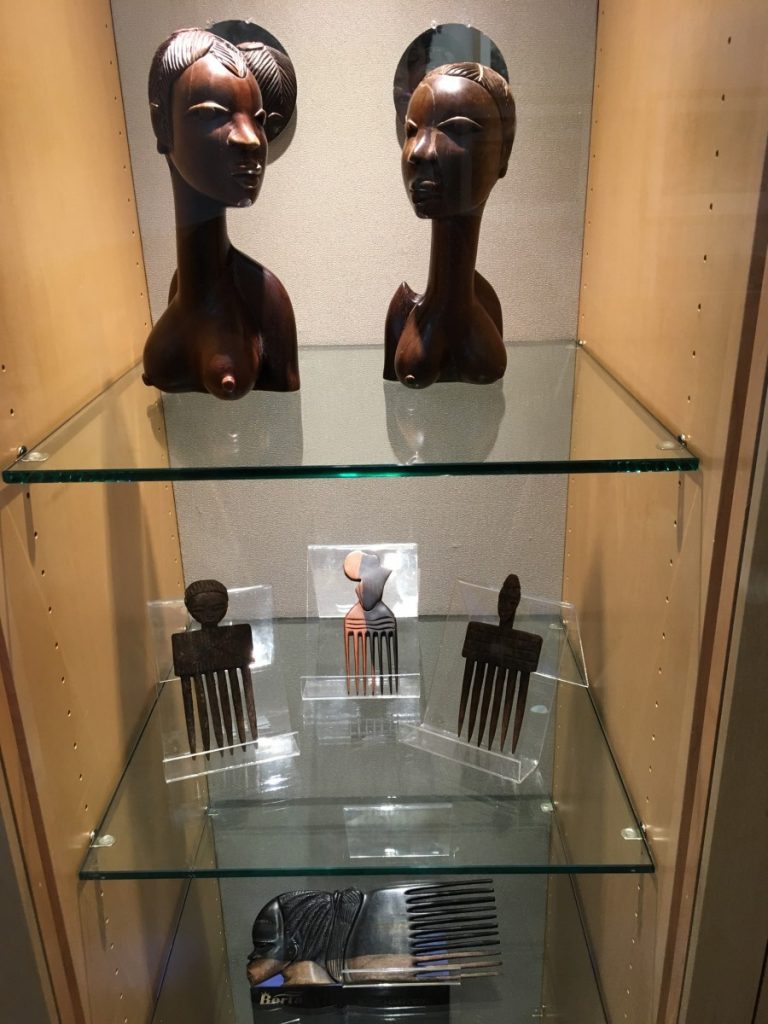
West African wooden busts with textured hair and wide-toothed, stylized wooden combs
KS: I confirmed what I suspected: with a little guidance, students can develop amazing, educational works that edify the community. At times in this process, after providing an idea and information about accessing the tools necessary to shape this exhibit, it was more helpful for me to shut my mouth, step back and let others work. I say that with no offense intended towards me. But my anxieties about timeline and fears about quality of presentation were not especially useful to the group. And my idea of what might be an appropriate scale and scope were potentially limiting to the group’s vision. So I “coup d’état-ed” myself so that others could lead and lead well. And they did. Over and over again. It is my honor to be even marginally associated with this project. It was everyone else who did the hard work.
As a relatively new resident in Vermont, there are some regional resources I didn’t know about, like the Clemmons Family Farm. Betty Kafumbe found ways to engage the greater Vermont community and to ensure the discourse we engaged was both local and international. I must praise her efforts. Christal Brown, too, contributed and expanded the project in ways I could not have anticipated. Her access to dramatic props like mannequins and her professional contacts enriched this project. I mean, if this is not community, what is?
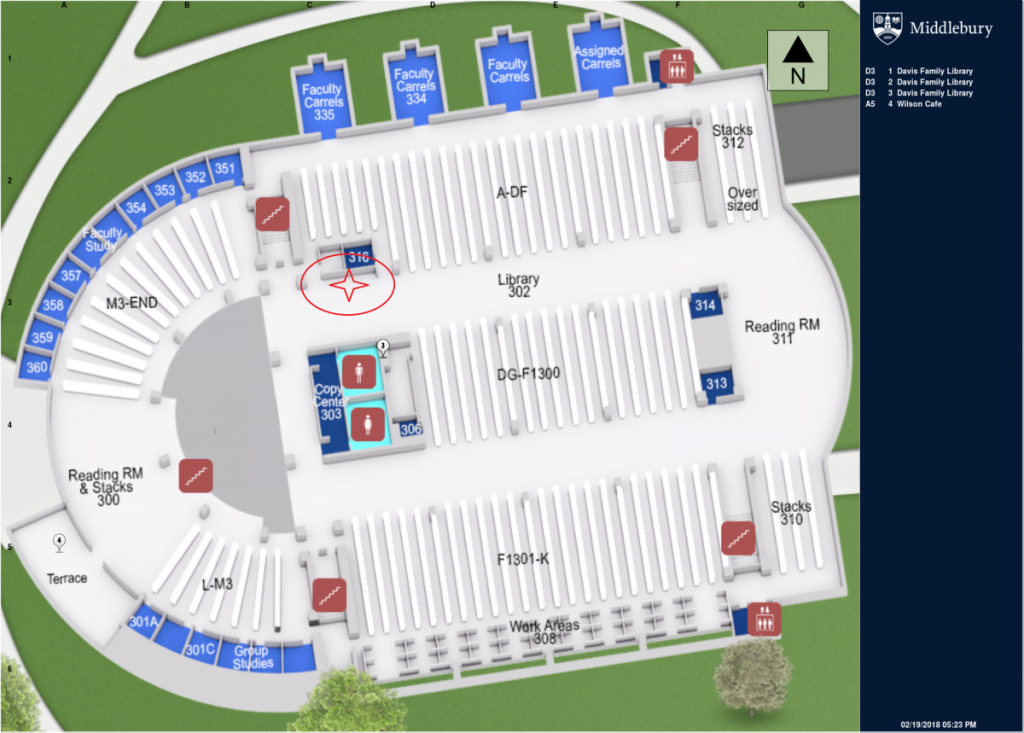
The red star on this map displays where the Hair Me Out exhibit can be found in the Davis Family Library, on the Upper Level, near the elevator, northwest corner of the building.
What’s next?
KS: Ooh, chile (<—African American Vernacular English, [@Marcos Rohena-Madrazo] also known as “AAVE”). We in the library got the Mixed Kids’ mixed race display; summin’ called “fat ‘n’ hairy: ways i’m failing the patriarchy” and “Resume of Failures,” too. Can’t stop, won’t stop. Don’t ask what they are. Just keep a look out for ‘em. Various speakers will engage the topic of Challenging White Supremacy on the 26th. And supported by the Middlebury College Activities Board (MCAB) and Women of Color (WOC), Jade Moses and Thandwa Mdluli are bringing a poet, Porsha O., to campus on February 27th. It’s dizzying, really. Or as we said during Black History Month Jeopardy, “It’s lit”: “luminous, dynamic, enjoyable.”
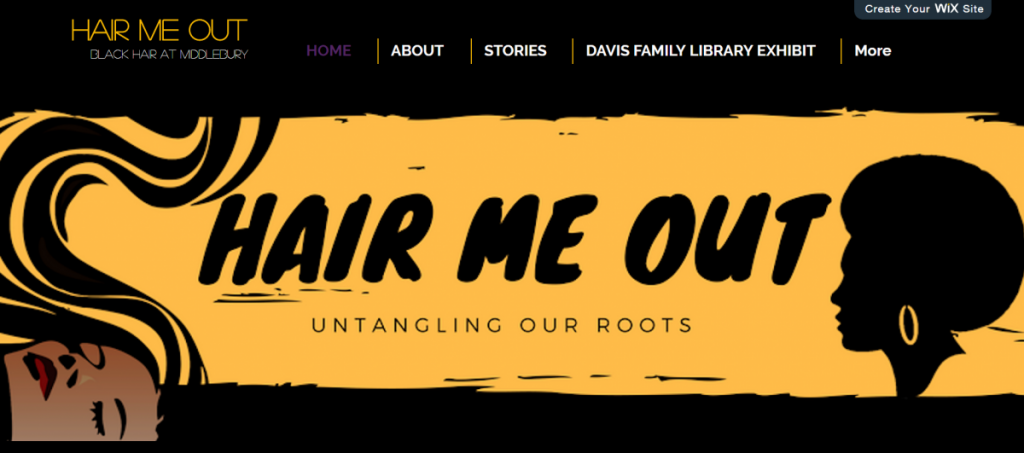
Not only do you do remarkable displays, you do remarkable write-ups about them.
Thanks, Bren! Stay tuned for more!